New Air Suspension for Tankers
Page 67

If you've noticed an error in this article please click here to report it so we can fix it.
EXPERIMENTS with pneumatic suspension systems on bulk-liquid transporters are being carried out by Thompson Bros. (Bilston), Ltd., Bilston, Staffs. So far all the tests have been a great success, and the company contemplate going into quantity production shortly with this equipment.
The constant periodicity 'offered by air springing should make it possible to reduce tank structure weight because of the reduction in shock loads when running light, and thus allow increased payloads. Tyre life should also be extended.
The vehicle body (1) shown in the illustration is a Thompson bulk-liquid tank and bears on the axle (2) through the medium of two or More rubber bellows (4), which are filled with"comprested air. This air is supplied from a reservoir (3), the pressure in which is maintained by the vehicle's air-pressure braking system. In the event of failure of the suspension, the brakes are safeguarded by a nonreturn valve.
The flow of air from the reservoir to the bellows is controlled by two levelling valves (5). The purpose of these is to maintain the static height of the vehicle, regardless of the load being carried. The full travel of the springs is thus always available to absorb road shocks.
When the tank is empty, the pressure in the bellows is about 30 p.s.i., sufficient to support the unladen weight of the tank. When liquid is loaded into the tank, the springs will deflect, causing the levelling valves to open and highpressure air to flow from the reservoir into the springs. When the static height has been restored, the levelling valves close, thus trapping air at the pressure required to support the load within the bellows.
Axle movements merely compress this trapped air, the transfer of extra air from reservoir to bellows under these condi Lions being prevented by a time-lag device incorporated in the levelling valves, giving some eight seconds delay. When the vehicle is cornering, this device also prevents air from leaking. from that spring under greater pressure, because of the sway of the load, to the other.
Air suspension is considered to be particularly suitable for bulk-liquid transporters because of the proportionately
higher disparity between laden and unladen weights compared with other vehicles. Leaf springs may give a .laden outfit a well-cushioned ride, but are too hard when the vehicle ,runs light so that an undue amount of shock is transmitted to the chassis.
An incidental advantage is that air springs need no lubrication ' and are unaffected by weather.
















































































































